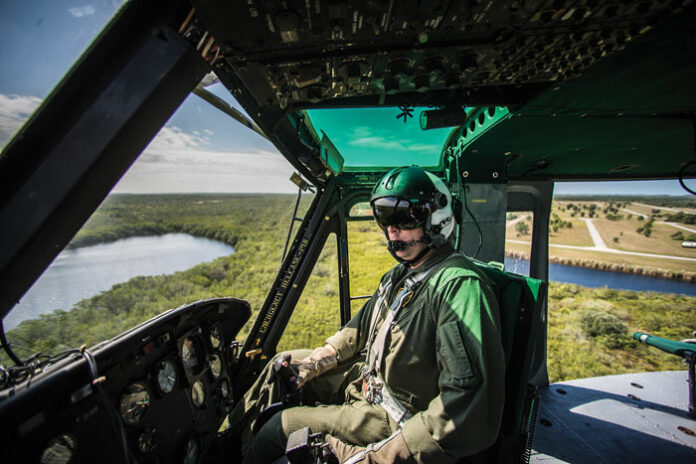While the majority of pilots in the ag industry have moved away from using a headset while flying; seeing the benefits of wearing a protective helmet and often spending thousands of dollars to purchase one, there is another area of safe operation that doesn’t get the same consideration – wearing a flight suit.
The first organization to wear flight suits in their current form was the U.S Army Air Corps, which developed the AN-S-31 flight suit, initially developed for fighter jets. While many advancements have been made since their introduction in World War II, the most important have factored around safety, and the introduction of Nomex material, developed by DuPont in 1964 after a horrific crash in the Indianapolis 500 took the lives of three drivers.
Within the year after the accident, Nomex was introduced into race suits, and shortly after that into flight suits as the flame-resistant properties were proven to the military. Military and civilian flight suits are now made of 92% Nomex and have been proven to withstand fires up to 370 degrees celsius.

Why Flight Suits?
In the ag flying, there are numerous compelling reasons to wear a flight suit —the first is cockpit safety. The cockpit of an ag plane is a cramped environment, one where clothing items can get caught on flight controls, quickly causing an emergency if a shirt sleeve or something in a pocket knocked a fuel lever or primary flight control in the wrong direction.
The second reason is the more obvious yet uncomfortable safety piece to mention: fires. Sadly, some ag aviation crashes that have occurred in the past have been survivable. Yet, the incident still resulted in the tragic loss of an ag pilot due to a post-crash fire and the thermal injuries sustained by the pilot in the post-crash fire.
While flight suits may have in the past had a negative connotation and be seen as worn by “fighter jocks,” the reason for wearing one today has nothing to do with wanting to be seen as a wannabe fighter pilot. The safety provided by a flight suit in the event of an accident now far surpasses any negative stigma, along with the broader adoption of another life-saving device that goes alongside flight gloves and that shiny new helmet.
It doesn’t matter if the message comes from a large professional organization like the NAAA, HAI for the helicopter world, or your best buddy that wears one; the message is clear and backed by endless statistics through decades of military use in addition to civil aviation; wearing a flight suit will likely save your life in a survivable crash that results in a post-crash fire. That is the fact that no one can deny. The list of lives saved is likely a long one, although there are no easy reference numbers without substantial research, unlike ejection seats.
Emily Daniel, an ag-pilot from New Jersey, is passionate about flying, having won several awards outside of the ag industry as a commercial flight instructor in Texas and recently winning the NAAA’s 2020 John Robert Horne Memorial award, reserved for a pilot with less than five years experience with an exemplary safety record. Emily’s focus on safety at her company, Wings Aerial Applicators, which she runs with her husband Austin and father-in-law Jeff have led to multiple safety-focused initiatives into the company’s day-to-day operations. This includes supplying Nomex flight suits for all pilots in the company.
For Emily Daniel, pushing for people in the industry to ditch the “flying in jeans and a t-shirt” mentality and switching to flight suits has become a passion. So much so that she started the ag aviation flight suit initiative, a Facebook group that has gained notoriety recently as more and more pilots move toward safer practices in the cockpit, some crediting Daniel and her efforts directly as their reason for making the switch.
The Ag Aviation Flight Suit Initiative
The movement started by Emily Daniel does not simply seek to encourage others to make the switch. At the same time, that is the group’s core mission; Daniel has gone above and beyond to make the switch easier for pilots, negotiating discounts on both flight suits and name tags to help move the needle in the right direction.
The group displays success stories of pilots that made the switch, along with helpful information for those looking to make the transition, recommending vendors that provide quality Nomex flight suits and even detailing the different products available, such as the recently added two-piece flight suit for those that are not comfortable with the single piece flight suit.
One of the most important things about a flight suit is fit. You don’t want a flight suit to be too tight; room to move is paramount. There are two types of flight suit sizings—long and short, which are self-explanatory as far as leg size. The sizing of a flight suit is akin to that of the sizing of a suit jacket somewhat. Still, for correct fitting, if you can attend a trade show like the NAAA show in Savannah, the best way to get a proper fit is to be measured on-site by one of the many vendors that provide flight suits at the show.
In addition to the safety aspect of wearing a flight suit, the functionality of wearing one is also essential. Pockets are placed in ergonomic locations and fitted with zipper closures to prevent items from compromising flight operations. However you fly, wearing a flight suit will give you a fighting chance, should the worst happen. A small investment on the front end could mean a life saved on the back.





